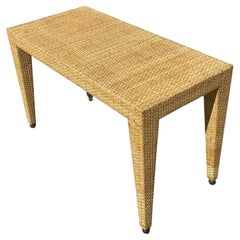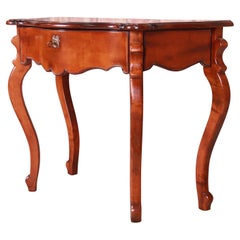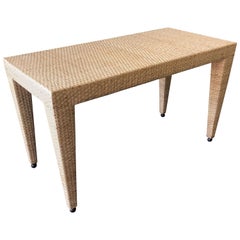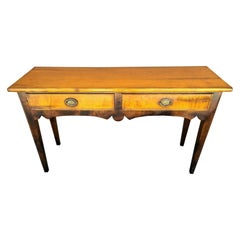Baker Milling Road Console
Late 20th Century Chinese Mid-Century Modern Console Tables
Metal
Late 20th Century Italian French Provincial Console Tables
Maple
Recent Sales
Late 20th Century American Console Tables
Wicker
Vintage 1980s Italian Console Tables
Maple
21st Century and Contemporary Louis XV Console Tables
Maple
Late 20th Century Italian French Provincial Console Tables
Brass
Late 20th Century American British Colonial Console Tables
Wood
Vintage 1970s American French Provincial Console Tables
Brass
Late 20th Century Louis Philippe Credenzas
Mahogany
1990s Unknown Chinoiserie Dry Bars
Metal
1990s American French Provincial Sofa Tables
Oak
People Also Browsed
21st Century and Contemporary Swedish Mid-Century Modern Table Lamps
Textile
2010s Organic Modern Console Tables
Ash, Hardwood, Bentwood
Antique Early 1900s French Art Nouveau Chandeliers and Pendants
Bronze
21st Century and Contemporary Mexican Mid-Century Modern Floor Lamps
Textile, Wood, Linen, Fiberglass
Early 20th Century American Art Deco Console Tables
Willow
Antique Late 19th Century French Louis XV Commodes and Chests of Drawers
Wood
2010s South African Minimalist Night Stands
Burl, Poplar
Early 20th Century American Art Deco Console Tables
Upholstery, Wicker
Vintage 1970s American Mid-Century Modern Console Tables
Wood, Laminate
Mid-20th Century Dutch Mid-Century Modern Desks and Writing Tables
Oak
Vintage 1970s American Mid-Century Modern Cabinets
Chrome
2010s American Chinoiserie Secretaires
Wood
Late 20th Century American Georgian Console Tables
Marble
Vintage 1970s Mid-Century Modern Console Tables
Resin
Vintage 1930s Austrian Art Deco Night Stands
Bakelite, Walnut, Plywood
Vintage 1940s Rustic Daybeds
Iron
Baker Milling Road Console For Sale on 1stDibs
How Much is a Baker Milling Road Console?
Baker Furniture Company for sale on 1stDibs
Owing to the company’s collaborations with many leading designers and artists over time, vintage Baker furniture is consistently sought after today. The heritage brand’s chairs, dining tables, desks and other pieces are widely known to collectors and design enthusiasts for their fine craftsmanship and durability.
Within a few decades of its launch, Baker Furniture Company evolved into one of the largest and most important furniture manufacturers in the United States and became known for its high-quality production standards. Siebe Baker and business partner Henry Cook founded the original iteration of Baker Furniture Company in 1890 in Allegan, Michigan, after immigrating to the United States from the Netherlands. Allegan is a small town west of Grand Rapids, which, at that time was home to Widdicomb Furniture Co. and more and was known as America’s furniture capital. The company manufactured doors and interior moldings and introduced a combination desk and bookcase in 1893. In the early 1900s, Siebe became the sole owner of the business.
Among others, stage designer Joseph Urban and modernist designer Kem Weber contributed designs to Baker in the 1920s. In 1932, under the leadership of Siebe’s son, Hollis, who started at the company as a salesman but took the reins when his father passed in 1925, Baker Furniture introduced bedroom pieces and debuted its Manor House collection, which made reproductions of European furnishings available to the American market. (Hollis was an avid traveler and procured antiques overseas for the company to reproduce in the United States.) Soon, Baker Furniture Company moved to Holland, Michigan, and eventually opened showrooms in Grand Rapids and elsewhere.
Pioneering Scandinavian designer Finn Juhl created a Danish modern line for Baker in 1951, and the company produced his award-winning Chieftain chair for a short time. In the late 1950s, Baker introduced the Milling Road label to reach a younger audience with stylish but less costly furnishings like console tables, walnut dining chairs and more, and in 1961, British furniture designer T.H. Robsjohn-Gibbings introduced a modern neoclassical line at Baker.
The 1960s and ’70s saw the introduction of historic reproduction furniture lines such as Woburn Abbey and the Historic Charleston collection, which remain very popular to this day. In 1990, Baker was licensed to produce a furniture line from Colonial Williamsburg. That same year, the Smithsonian Museum introduced Baker’s Chippendale chair into its permanent collection and the Grand Rapids Art Museum dedicated an exhibition to Baker’s 100th anniversary, a showcase that included 150 pieces of furniture Siebe Baker had collected as part of a larger assortment that had served as inspiration for his designs.
Today, vintage Baker furniture, such as its elegant mahogany nightstands and teak credenzas — particularly those crafted by Finn Juhl — sees high demand online and elsewhere. The company continues to produce contemporary collections with well-known designers such as Bill Sofield, Barbara Barry and Kara Mann and remains on par with some of the highest quality furniture in the industry.
Browse vintage Baker armchairs, sofas, coffee tables and other furniture on 1stDibs.
Finding the Right Console-tables for You
Few pieces of furniture are celebrated for their functionality as much as their decorative attributes in the way that console tables are. While these furnishings are not as common in today’s interiors as their coffee-table and side-table counterparts, console tables are stylish home accents and have become more prevalent over the years.
The popularity of wood console tables took shape during the 17th and 18th centuries in French and Italian culture, and were exclusively featured in the palatial homes of the upper class. The era’s outwardly sculptural examples of these small structures were paired with mirrors or matching stools and had tabletops of marble. They were most often half-moon-shaped and stood on two scrolled giltwood legs, and because they weren’t wholly supported on their two legs rather than the traditional four, their flat-backed supports were intended to hug the wall behind them and were commonly joined by an ornate stretcher. The legs were affixed or bolted to the wall with architectural brackets called console brackets — hence, the name we know them by today — which gave the impression that they were freestanding furnishings. While console tables introduced a dose of drama in the foyer of any given aristocrat — an embodiment of Rococo-style furniture — the table actually occupied minimal floor space (an attractive feature in home furniture). As demand grew and console tables made their way to other countries, they gained recognition as versatile additions to any home.
Contemporary console tables comprise many different materials and are characterized today by varying shapes and design styles. It is typical to find them made of marble, walnut or oak and metal. While modern console tables commonly feature four legs, you can still find the two-legged variety, which is ideal for nestling behind the sofa. A narrow console table is a practical option if you need to save space — having outgrown their origins as purely ornamental, today’s console tables are home to treasured decorative objects, help fill empty foyers and, outfitted with drawers or a shelf, can provide a modest amount of storage as needed.
The rich collection of antique, new and vintage console tables on 1stDibs includes everything from 19th-century gems designed in the Empire style to unique rattan pieces and more.



